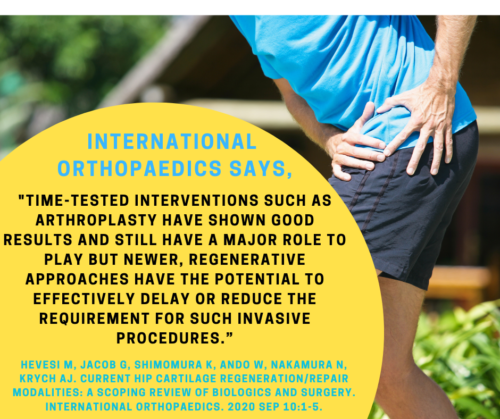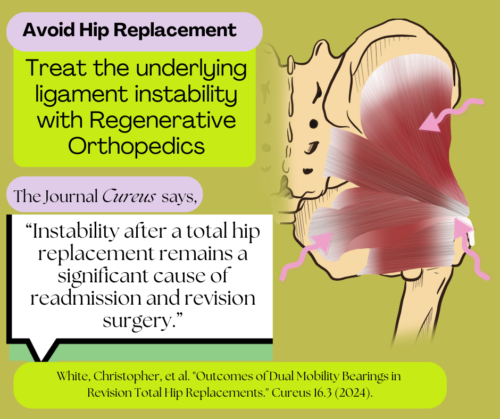 Hip Arthritis Treatment and the Ligament Connection
Hip Arthritis Treatment and the Ligament ConnectionIf you have hip arthritis, there is a good chance you are looking for an alternative to hip replacement. Are you seeking a way to preserve your hip from hip replacement surgery? What is the best hip arthritis treatment?
For those who still have good range of motion in their hip, Regenerative Orthopedics may be your alternative to hip replacement. Regenerative Orthopedics is a non-surgical regenerative therapy that includes Prolotherapy, PRP, and Stem Cell Therapy. At OrthoRegen®, we use the Gold Standard in Stem Cell Therapy.
Total hip replacements are the most commonly performed hip procedures, with almost one million performed in the world every year (1). As the life expectancy of people worldwide increases so does the number of hip replacement procedures. When hip replacements fail, the patient then faces revision surgery.
When hip replacements fail, the frequent cause is instability. And after revision surgery the rate instability is quite high, reported as 9.8-25% (2). Interestingly, the underlying culprit that leads to arthritis and possible hip replacement in the first place, is instability. Confronting and addressing the instability problem in a timely fashion with Regenerative Orthopedics can resolve the problem.
Often, hip replacement is chosen because the patient is told they have bone-on-bone arthritis, and hip replacement is the only option. As you read, you will see that hip replacement is not the only option for bone-on-bone arthritis, but Regenerative Orthopedics is practical in many arthritis cases.
Many people assume that once they get a hip replacement, they will be good to go, and can get back to all the activities they want. This is not always the case. Some people continue to have pain after the replacement. And as we said earlier, instability in the hip may continue to cause havoc.
Additionally, it’s essential to remember that hip replacements do not last forever. If the patient is younger, remember that replacements will wear out after 15-plus years.
Hip replacements may not provide the desired relief sought. Instead, chronic pain and incomplete function after surgery is a possibility. And surgery is permanent. Once surgery is done, it cannot be undone. Fortunately, there is an alternative! Regenerative Orthopedics is an effective hip arthritis treatment that can help get you back to the activities you enjoy.
Let’s get back to the root cause of hip arthritis. The cycle of hip arthritis begins sometime after an injury occurs to the hip joint. That injury could have been an acute trauma-type injury. Or the damage is due to wear and tear over time. The injury then causes the hip joint to move abnormally. Once the soft tissue, like tendons, ligaments, and even the hip labrum, become injured, worn, and/or weakened, they allow for the hip joint to become unstable. The hip instability then causes further joint injury. The cartilage that lines the hip joint also degenerates, and sclerotic changes can be seen on an x-ray, and arthritis is diagnosed.
Is the cartilage degeneration causing the pain? Interestingly, cartilage has no nerve endings, so the pain is not coming from the cartilage. Ligaments, however, are highly innervated. They do have nerves. And when injured, can elicit pain. Therefore, the injured, weak ligaments can be the source of joint pain.
People do not wake up one morning with advanced bone-on-bone hip osteoarthritis. Something did cause it. Bone-on-bone hip osteoarthritis is the end result of continued, prolonged, unrelenting hip joint degeneration due to damaged, loose hip ligaments…or hip instability.
Fortunately, Regenerative Orthopedics treats the weak, injured, and lax ligaments and other soft tissue structures of the hip that are in need of repair. The treatments do not just cover up pain, as pain meds and anti-inflammatories do. Regenerative Orthopedics regenerates and repairs the hip.
The three main ligaments of the hip, the iliofemoral, pubofemoral, and ischiofemoral ligaments, are very strong. Normally, when these ligaments are healthy, they keep your hip stable. But when they become injured, the hip becomes unstable. With the instability, the hip labrum and other soft tissue begin to tear. And the ball of the hip bone rubs the wrong way and causes the degeneration to continue. Researchers agree about the importance of healthy ligaments in order to have a healthy hip joint.
When examining why patients continue to have pain after hip surgery, Researchers said this in the Knee Surgery, Sports Traumatology, Arthroscopy journal, “surgical management for hip disorders should preserve the soft tissue constraints (ligaments) in the hip when possible to maintain normal hip biomechanics.”(3) As we mentioned earlier, abnormal motion in the hip from injured ligaments leads to the arthritis cycle, and instability is also a common reason for hip replacement failure.

Repair the Ligaments; Treat the Hip Instability
Plus, a study in the Journal of Biomechanics explained the importance of hip ligaments while stressing the need to save the ligaments writing, “Laboratory data indicate the hip capsular ligaments prevent an excessive range of motion, may protect the joint against adverse edge loading, and contribute to synovial fluid replenishment at the cartilage surfaces of the joint. However, their repair after joint preserving (hip arthroscopy) or arthroplasty (hip replacement) surgery is not routine.” (4)
Regenerative Orthopedics not only saves the ligaments…it repairs the ligaments.
The researchers stress the importance of preserving the ligaments. Clearly, the bone-on-bone situation is not the only problem that needs to be addressed in the degenerated hip. It is vital to repair the injured ligaments because if not, the problem and the pain can continue. The hip needs to be treated comprehensively.
A February 2021 paper in the journal International Orthopaedics offers this opinion on the future of surgery: “Orthopedic surgeons are at an exciting crossroads in medicine, where hip biologic therapies are evolving and increasingly available. Time-tested interventions such as arthroplasty have shown good results and still have a major role to play but newer, regenerative approaches have the potential to effectively delay or reduce the requirement for such invasive procedures.” (5)
There are certainly times when surgery is needed. However, regenerative treatments are great alternatives in many cases.
Let’s look at some of the studies and see what they say about the effectiveness of regenerative therapies like Prolotherapy, PRP, and Stem Cell Therapy.
Prolotherapy
Hauser et al. looked at 61 patients with hip pain, and 95% said their pain decreased after Prolotherapy. (6)
Researchers in the journal Medical Science Monitor said, “To our best knowledge, this study is the first regarding the effects of an injection method in treating osteoarthritis secondary to developmental dysplasia of the hip. According to our study, Prolotherapy is superior to exercise. Prolotherapy could provide significant improvement for clinical outcomes in developmental dysplasia of the hip and might delay surgery.” (7)
PRP
As far as PRP, the American Journal of Sports Medicine journal says this: “Results indicated that intra-articular PRP injections offer a significant clinical improvement in patients with hip osteoarthritis without relevant side effects.” (8)
Stem Cell Therapy
At OrthoRegen®, we may use PRP and Stem Cell Therapy in cases where the hip degeneration is more advanced. We call this the Gold Standard in Stem Cell Therapy because we will use Prolotherapy, PRP, and stem cells to comprehensively treat all of the injured structures of the hip joint.
Clinical Medicine Insights: Arthritis and Musculoskeletal Disorders shows that stem cells regenerate tissue damage within the osteoarthritic joint and, when used in combination with Prolotherapy injections, can repair hip stability. (9)
At OrthoRegen, we’ve had years of experience in regenerative therapies as a hip arthritis treatment. If you are suffering from hip arthritis and are looking for an alternative to hip replacement, please call us. We’d love to help you stop the arthritis cycle and repair the damaged hip structures so you can return to the activities you love.
(1) Pivec R, Johnson AJ, Mears SC, Mont MA: Hip arthroplasty. Lancet. 2012, 380:1768-77. 10.1016/S0140- 6736(12)60607-2
(2) Ben-Shlomo Y, Blom A, Boulton C, et al.: The National Joint Registry 19th Annual Report 2022 . National Joint Registry, London; 2022. https://www.ncbi.nlm.nih.gov/books/NBK587525/.
(3) Smith MV, Costic RS, Allaire R, Schilling PL, Sekiya JK. A biomechanical analysis of the soft tissue and osseous constraints of the hip joint. Knee Surgery, Sports Traumatology, Arthroscopy. 2014 Apr 1;22(4):946-52.
(4) Van Arkel RJ, Amis AA, Jeffers JR. The envelope of passive motion allowed by the capsular ligaments of the hip. Journal of Biomechanics. 2015 Nov 5;48(14):3803-9.
(5) Hevesi M, Jacob G, Shimomura K, Ando W, Nakamura N, Krych AJ. Current hip cartilage regeneration/repair modalities: a scoping review of biologics and surgery. International Orthopaedics. 2020 Sep 10:1-5.
(6) Hauser RA, Hauser MA. A Retrospective Study on Hackett-Hemwall Dextrose Prolotherapy for Chronic Hip Pain at an Outpatient Charity Clinic in Rural Illinois. Journal of Prolotherapy. 2009;2:76-88.
(7) Gül D, Orsçelik A, Akpancar S. Treatment of Osteoarthritis Secondary to Developmental Dysplasia of the Hip with Prolotherapy Injection versus a Supervised Progressive Exercise Control. Med Sci Monit. 2020;26:e919166. Published 2020 Feb 11. doi:10.12659/MSM.919166
(8) Dallari D, Stagni C, Rani N, Sabbioni G, Pelotti P, Torricelli P, Tschon M, Giavaresi G.Ultrasound-Guided Injection of Platelet-Rich Plasma and Hyaluronic Acid, Separately and in Combination, for Hip Osteoarthritis: A Randomized Controlled Study. Am J Sports Med. 2016 Mar;44(3):664-71. doi: 10.1177/0363546515620383. Epub 2016 Jan 21
(9) Hauser RA, Orlofsky A. Regenerative injection therapy with whole bone marrow aspirate for degenerative joint disease: a case series. Clin Med Insights Arthritis Musculoskelet Disord. 2013 Sep 4;6:65-72. doi: 10.4137/CMAMD.S10951. eCollection 2013.